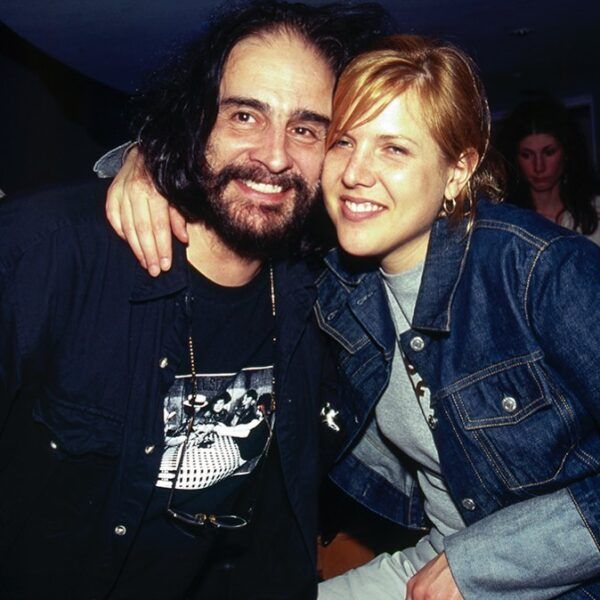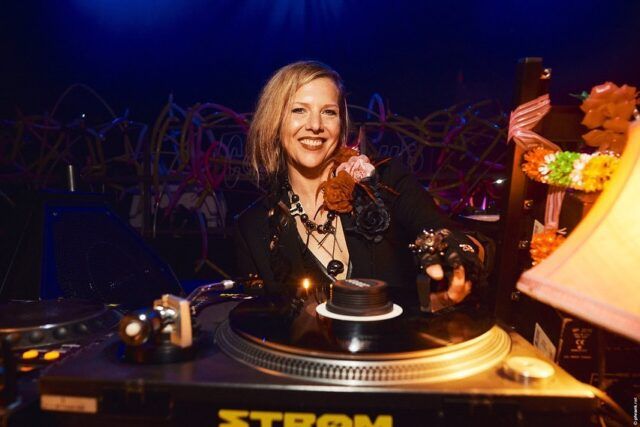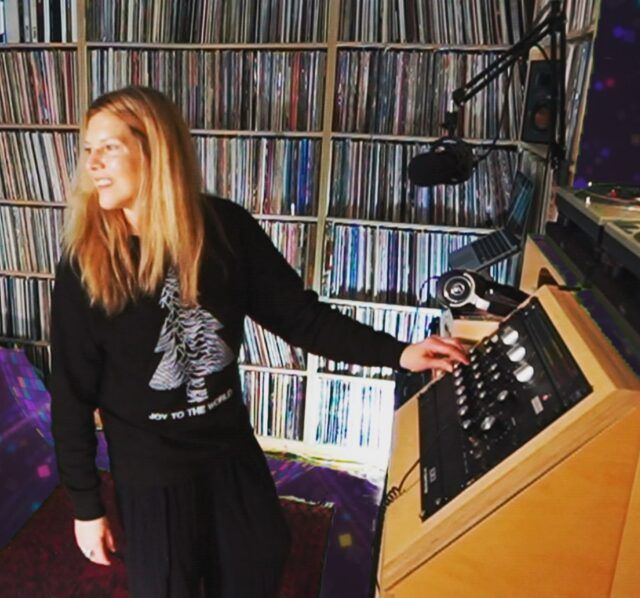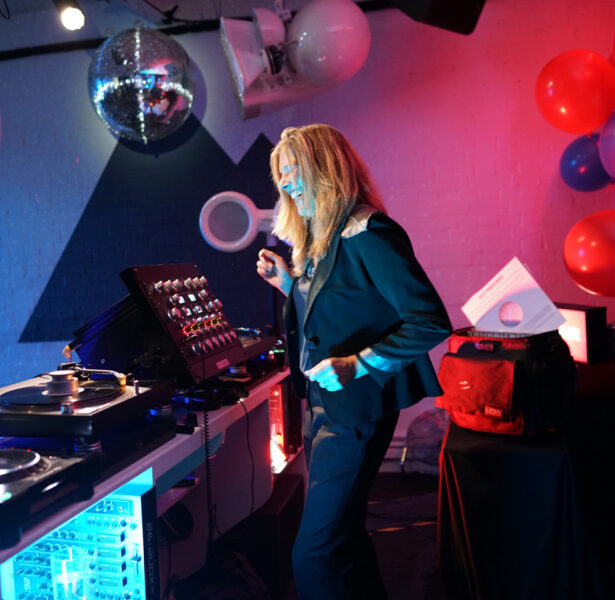Colleen Murphy is a broadcaster, producer and DJ. She’s most recently remixed A Certain Ratio, Mildlife and Róisín Murphy and has just released her Cosmodelica remix of Lady Blackbird’s ‘Lost And Looking’. We thought it would be a good opportunity to talk to her about her DJ career, working with the legendary David Mancuso and to get some seriously detailed insights into audiophile sound systems from a genuinely professional DJ.
Who is Colleen Murphy? Broadcaster, DJ, producer, songwriter, remixer, journalist, Classic Album Sunday’s originator, Lucky Cloud Sound System co-founder, Worldwide FM DJ and protégé of David Mancuso – Colleen Murphy has some impressive DJ credentials.
Hit play and read on.
Here’s a live set of Colleen DJing from 2020:
And here’s a video clip of Colleen headlining the Love Dancin’ sound system at Gilles’ WoH 2021.
Our first question is about David Mancuso. Can you tell us a little about your relationship with David and how it influenced your DJing? You were mentored by him, is that right?
I met David nearly 30 years ago and whilst I lived in New York City was a back-up musical host, playing records with him and also filling in for him. When I moved over to the UK in 1999, I initiated and co-produced The Loft compilations with David for Nuphonic. Around that time, David and I played together at parties around Europe and even Russia which was a trip. We started a London version of The Loft, the Lucky Cloud Loft party in 2003 which is still going strong today. I worked with him on his record label The Loft Audiophile Library of Music and he later brought me back to New York to musically host at The Loft, assist with the sound system set-up and help oversee his legacy. We had a tight working relationship but also a deep friendship that grew stronger and stronger with time.
I learnt so much from him, not only about the nature of sound and audio equipment set-up, but also how to approach playing records for a dancefloor with the aim of raising people’s life energy. His style of musically hosting was the polar opposite of many DJs in that the goal was to drop the ego rather than draw attention to oneself. He didn’t want the ego to supersede the music. He had great respect for the musicians and didn’t want to alter their intention, hence no mixing but playing records in full on a sound system that would allow people to hear the details in the original recording. I completely abide by these principles when musically hosting at Lucky Cloud and The Loft, but I also bring a similar sensibility and approach to my DJ-ing in other situations in which I do mix.
Some of our younger readers may not be aware of Mancuso’s influence or legacy. Could you tell us a little about his place in DJ history?
You could write a book about this and in fact, my friend Tim Lawrence did so! If anyone wants the full story they should read ‘Love Saves the Day’. But in a very small nutshell, David started a weekly ‘rent party’ in his downtown Manhattan loft-space in 1970 bringing together people from all walks of life irrespective of race, gender or sexual orientation for the sole purpose of building friendships through the power of dance. He was an audiophile and put together the best sound system, playing records that would tell a story over several hours. The party became known as The Loft and even though it was private, it became the place to be. His musical style and sound system inspired nearly every DJ and club that sprang up in it’s wake from Larry Levan at the Garage to Frankie Knuckles at the Warehouse. Even after David’s passing, The Loft party and its London off-shoot that David co-founded with myself and some friends are both going strong.

How would you describe your personal DJ style? What kind of music do you play?
Good music from across the board.
And can you say what it is that makes a tune work on the dance floor?
It needs to connect with people emotionally, physically and sometimes even spiritually. Great dancefloor tunage spans the emotional spectrum – some songs uplift with lyrics of nourishing positivity and some are sonic excursions that take your mind and body to another plane. Of course, a great bassline always helps.
So when you play a gig, what equipment do you bring with you?
It really depends upon the gig and how much I’m able to bring along. My overall goal is to enhance the sound as much as possible in a given situation. As a working DJ, I have played in a variety of spaces, each with their own acoustics and sometimes I have to rely upon some of the equipment that permanently lives in the venue. I always get the audio specs before agreeing to play and do a proper soundcheck before doors open. It’s very important to know where and with what you are working, to be aware of any limitations and to hear what the room sounds like. Room acoustics can sometimes dictate what you can play (especially bass-heavy records in a reverberant room).
I always bring my own Audio Technica VM760SLC cartridges that I set up with the correct tracking force. I require two properly serviced Technics 1200s which means the counterbalance, pitch control and anti-skate must be in good working order and the turntables need to be levelled. At home my turntables have a separate power supply so there is less interference with the platter but that’s not a realistic demand (wink). The turntables must be properly isolated to prevent ground feedback so sometimes I bring my own isolation platters that can be used in a joyous jigsaw of concrete slabs and Heres feet and I always bring slipmats for further isolation, and MasterSounds record weights. I always use a rotary mixer – the Isonoe ISO420 which sounds fabulous and travels well, and I use an original Bozak CMA-10-2DL with a custom-built audiophile 3-way crossover at home. Sometimes I bring the custom Trojan mixer with me which is a custom-built audiophile beast (that’s the one I used for my Boiler Room set).
The Love Dancin’ Soundsystem which my husband (Daddy Ad of Trojan Sound System) and I put together for We Out Here festival goes a few steps further as we bring in the entire sound system. This includes Moon phono stages for the turntables, Moon DACs for the CDJs, Chord Sarum interconnects and mains cabling, ISOL-8 power conditioner, and Danley Loudspeakers. This past year we beta tested the new Hyperion hi-fi speakers which Tom Danley built over the pandemic and aren’t even released yet.
For the Lucky Cloud and The Loft parties, the entire sound system is also plugged in which includes Koetsu moving coil cartridges, Mark Levinson ML-1 preamplifier, Class A power amplifiers (either by Mark Levinson or Sugden), a custom-made dividing network, a delay and Klipschorns.

Klipschorns are your preferred speakers, correct?
I love Klipschorns – I have a pair at home and we also use them for the Last Note, Lucky Cloud and Loft parties. They are highly efficient loudspeakers because they are 3-way horn loaded and don’t require much power to drive. Their sensitivity rating is great – they can go up to 106 dB in ideal situations – and so they have less distortion. They are warm and wonderful for home listening and big parties.
I also love Danley loudspeakers and have been using them in my more club-oriented and festival gigs. Tom Danley is a big fan of Paul Klipsch’s horn design and has applied his physics brain and modern tech into the equation. He has patents for multiple entry horns – 3 or more drivers for a single horn. They are efficient with incredible coverage and sound musical and powerful at the same time.
Do you have preferred cartridges? What are they, and why?
I prefer to use hi-fi cartridges/styli rather than DJ cartridges/styli because of the tracking force. Hi-fi cartridges track at a lower weight (1.8 – 2.2 grams) and have more sensitivity and dynamics. DJ cartridges track in the region of 3 to 6 grams, press heavily into the grooves and to my ears, overly accentuate the bass and have less sensitivity and dynamics resulting in a duller sound. For most situations, I use high end moving magnet cartridges – Audio Technica VM760SLC.
At Lucky Cloud, Last Note and The Loft, we use Koetsu moving coil cartridges which sound even more dynamic, but they are sensitive – they like the right situation and a light hand. The output is lower than moving magnets, so must be boosted by a step-up transformer or phono stage. And they require a lot more isolation in a dancing situation – layers of concrete, stone, rubber matting – but once they are warmed up, the music sure does sing.

Talk us through what an audiophile sound system consists of.
The first thing to consider is room acoustics. It doesn’t matter what equipment you have, if the room sounds bad, the equipment will sound bad. As we say in America, ‘you can’t polish a turd.’
There is no single magical formula behind an audiophile sound system as the equipment comes in all shapes and sizes from digital to analogue and there are many different philosophies behind the varying designs of turntables, amplifiers, cabling and loudspeakers. I have used many different designs in many different situations from Lucky Cloud and The Loft to Classic Album Sundays and have achieved great results with a variety of set-ups. Ultimately, what you use is a mixture of pragmatic concerns such as cost and the contextual setting. For instance, one would hesitate to use a suspended turntable in a live performance situation due to skipping, but at home they are amazing.
In terms of the final result, one can use oscilloscopes and measure frequencies but ultimately when you get to a certain level of ‘wow, this sounds amazing’ and then it becomes more subjective. Some people want a more transparent sound, some want it more coloured. Some people like digital, some like analogue. The ultimate goal is for the music to sound as the artist intended but how you get there and what that means to you is variable.
Why do you think that high-quality sound equipment is so important? What value can it add to a night?
I think the answer is in the question as why would somebody want low-quality sound equipment – cheeky answer I know but it’s true, right? And to quote David, “Good sound is a human right.”
Some people aren’t necessarily consciously aware that they are listening to a high-quality sound system, but you can see how they positively respond through their behaviour, their visible emotional state and their longevity on the dance floor. Long-term exposure to distortion and sound pressure levels that exceed well over 100 dB for hours and hours isn’t good for people – not only in terms of hearing loss but also their emotional state. It slowly and subconsciously becomes more of an endurance test rather than a state of joy. Whoever is in control of the music and sound system ultimately has a lot of responsibility.
Many, many times when playing records on a world-class sound system, such as that at Lucky Cloud or The Loft, people will come up and ask what record I’m playing and then respond, ‘Oh I have that record and it never sounded like that’. It’s because they can hear more of the music and they can hear it clearly. The music sings and raises people’s emotional state rather than detract from it.

Did you ever have a single moment when you realised that DJing was what you wanted to do, a dance floor to Damascus moment?
No, I didn’t. It was a natural evolution from being a radio host and then doors opened and situations presented themselves, and the harder I worked, the luckier I got. I also started at a time when there weren’t many international touring DJs – I actually didn’t know of any until Tony Humphries was brought over to be a resident at Ministry of Sound and I went along to his last night at Zanzibar in Newark, New Jersey which was magical. Even though I was DJ-ing regularly, I always had other musical activities going on simultaneously. If I had to come up with an umbrella term for everything I do, it would be ‘musical curator and educator’.
And finally, what does DJing mean to you?
The joy of sharing music.
Colleen ‘Cosmo’ Murphy’s Cosmodelica Remix ofLady Blackbird ‘Lost And Looking’ is available now – you can grab it on Beatport.





